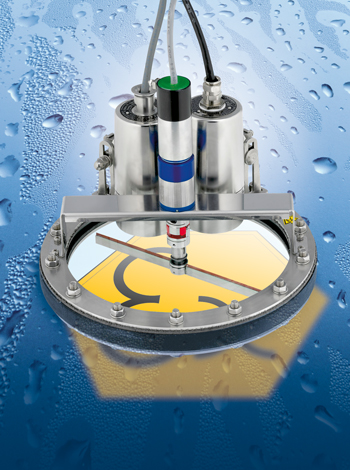 |
| January 20, 2015 | Volume 11 Issue 03 |
Designfax weekly eMagazine
Archives
Partners
Manufacturing Center
Product Spotlight
Modern Applications News
Metalworking Ideas For
Today's Job Shops
Tooling and Production
Strategies for large
metalworking plants
Mini motors power wipers in extreme reactors
Explosion-protected miniature drives used in window wipers ensure a clear view for reactor sight glass.

Many processes in chemistry, pharmacy, and biotechnology are automatically controlled. Nevertheless, a glimpse into what is happening at the reactor is often desired. As many reactor vessels are set up in a potentially explosive area, special requirements apply. Papenmeier GmbH & Co. KG, in its Lumiglas division, specializes in sight glass assemblies. In order to guarantee a clear view for automated equipment such as camera monitoring systems, the cleaning processes for the glass also had to be automated. Window wipers with ex-protected micro motors provide the necessary transparency in this application.
Things tend to heat up in reactor vessels in the truest sense of word. The medium is thoroughly stirred by agitators, new reagents are streamed in through conduits, and the reaction often results in bursting bubbles. All of these events mean that liquids splash in every direction naturally, onto the sight glass as well. In other words, window cleaning is required to maintain a clear view into the vessel.
Wipe-away effect
Spray nozzles are not always suitable for cleaning sight glasses; sometimes it is necessary for the wipers to perform manual work. The major disadvantage of this solution is that it requires local operation. The Lumiglas experts took on this problem and developed a motorized wiper that can also be remote controlled. This enables camera-supported monitoring solutions without major personnel expense.
Particularly in process engineering, special attention must frequently be given to the specific, potentially explosive atmosphere surrounding the system. All mechanical and electrical components must therefore be designed with protected constructions. In the case of window wipers, this necessitates a smooth-running yet gas-tight shaft feed-through in the reactor. The drive motor must also fulfill the relevant requirements. The same applies to the necessary gearing for increasing torque. As large drives would obscure the view into the relatively small sight glasses, a further requirement is the smallest design possible. Media that are rough or fibrous to wipe require a high torque on the part of the wiper shaft. These were all requirements that the FAULHABER drive developers needed to take into account when producing the suitable motor concept.
Pressure-resistant casing
 There are several possible ways of realizing an explosion-proof device. The pressurized enclosure Ex p, the oil immersion Ex o, or the encapsulation Ex m, among others, are state of the art. As the motor has a collector and brushes, sparks are produced during operation. Therefore, only pressure-resistant casing can be used for ignition protection. This means that all components that could ignite a spark are embedded into an enclosure that can withstand explosion pressure. The openings of the enclosure are furnished in such a way that outward transmission of the explosion is prevented.
There are several possible ways of realizing an explosion-proof device. The pressurized enclosure Ex p, the oil immersion Ex o, or the encapsulation Ex m, among others, are state of the art. As the motor has a collector and brushes, sparks are produced during operation. Therefore, only pressure-resistant casing can be used for ignition protection. This means that all components that could ignite a spark are embedded into an enclosure that can withstand explosion pressure. The openings of the enclosure are furnished in such a way that outward transmission of the explosion is prevented.
The motor casing was developed for the highest possible explosion class IIC (this includes IIA and IIB) and is also authorized for zones 1 and 2. The temperature class is T5, and the highest possible class T6 is available upon request. With the exception of the motor shaft feed-through (IP 54 in accordance with EN 60529), the motor has been implemented in protection class IP 68.

In motor practice, this means that despite the pressure-resistant casing, the coreless brush dc motor at a length of 80 mm and diameter of 35 mm is hardly larger than a comparable non-ex-protected motor. With a supply voltage of 24 VDC and a maximal possible continuous current of 0.5 A, the motor achieves up to 9 W of shaft power for an ambient temperature of 40 C. The efficiency factor is over 75 percent. The small rotor weight of the skew wound permits a high rate of acceleration. Specially adapted attachment planetary gearheads (32 to 63.5 mm in length, 35 mm in diameter) increase the torque to up to 10 Nm. The speed reduction range, depending upon the number of stages (one to five stages) spans from 3.71: 1 to 1,526: 1. Motor and gearing are connected directly in the plant, thereby ensuring the protection class. Protection against unauthorized heating is achieved by two integrated thermal fuses. For secure operation, only one fuse is necessary; if a disturbance has triggered a fuse, continued operation is possible with the second.
Whether as a protected version for vacuum, compressed air, or liquid pumps or as a specially designed drive solution for sophisticated positioning tasks, explosion-proof miniature drives open up a variety of new application fields within the explosion hazardous areas of process engineering.
To learn more about coreless dc motors from MICROMO, contact an engineer, or visit the MICROMO product selector to view offered configurations and motor sizes.
Source: MICROMO
Published January 2015
Rate this article
View our terms of use and privacy policy
